New Stuff[hide]
Reportes: From The St... : Cubadisco 2...
Fotos: Tom Ehrlich
Staff: Kristina Lim
Musicos: Juan Formell
Musicos: Yordamis Megret Planes
Musicos: Yasser Morejón Pino
Musicos: José Luis "Changuito" Quintana...
Musicos: Dennis Nicles Cobas
Fotos: Eli Silva
Grupos: Ritmo Oriental : 1988 - Vol. IX - 30 a...
Musicos: Rafael Paseiro Monzón
Musicos: Jiovanni Cofiño Sánchez
Fotos: Tom Ehrlich : 2024 Monterey Jazz, P...
Resenas: Vacilón Santiaguero (Circle 9 ...
Photos of the Day [hide]
SpanishEnglishHistory - Los Changueros de Hoy
THE CHARANGUEROS OF TODAY
by Majela Serrano ©2002
updates by Michelle White 2004-2007
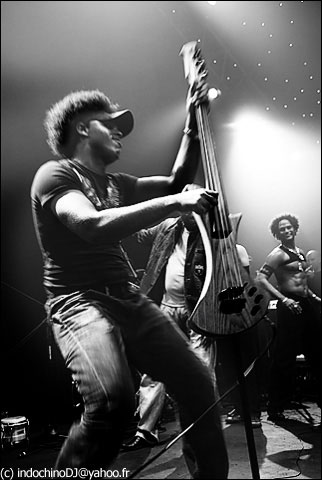 Ernesto Masa Kindelán is the only Charanguero to go from Charanga Forever to Charanga Habanera. He joined in April 2006 after Randolph left.
Ernesto Masa Kindelán is the only Charanguero to go from Charanga Forever to Charanga Habanera. He joined in April 2006 after Randolph left.
Ernesto was born in Santiago de Cuba in 1984. He attended el ISA and later joined Charanga Forever where he worked as Musical Director and recorded on the new Charanga Forever CD, Somos Charangueros.
When Randolph left la Charanga Habanera, Calzado invited Ernesto to join. Ernesto plays both the electric bass and the baby base during the charanga concerts.
Ernesto is a technically excellent player, but also displays an enthusiasm and energy that are pure Charanga.
***
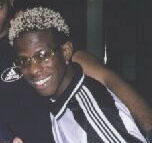 Junio Romero Valdés was born in Pinar del Río on February 20, 1975. He grew up there and studied at the Escuela Nacional de Instructores de Arte. When he finished his studies in 1996, he relocated to Havana and immediately began to work with Bamboleo, recording on their second album, "Yo no me parezco a nadie" and also on the CD they made with Rolo Martínez, "Para bailar mi son". Since 1998 he's been, as he puts it "ahí, tranquilo, trabajando con David". ("right here, very calmly working with David Calzado").
Junio Romero Valdés was born in Pinar del Río on February 20, 1975. He grew up there and studied at the Escuela Nacional de Instructores de Arte. When he finished his studies in 1996, he relocated to Havana and immediately began to work with Bamboleo, recording on their second album, "Yo no me parezco a nadie" and also on the CD they made with Rolo Martínez, "Para bailar mi son". Since 1998 he's been, as he puts it "ahí, tranquilo, trabajando con David". ("right here, very calmly working with David Calzado").
But "calm" is the last word anyone else would ever use to describe Junio Romero! In addition to his impeccable trumpet playing, he's a tremendous dancer and never stays still for a moment. Virtually all Cubans are great dancers, but Junio has a special "swing" and grace of movement that's magical to watch. Of the four brass players, he always stands on the outside and between his dancing and the vivid contrast of his dark black skin and bright orange hair, it's impossible to take your eyes off of him. His style and the joy he puts into his work is contagious and when you see him dance and laugh you can't help but do the same!
***
 As Jerry Rivera would say, "with the face of a boy, and the soul of a man". One of the youngest members of La Habanera, Helder Rojas Varona will turn 21 on the 23rd of March, 2002. He comes from an extremely musical family, going back to the days of his grandfather, the composer Ñico Rojas. His parents and sister are all musicians as well...and very good ones. They're sweet, simple, and attractive as well, and, of course, Helder is no exception.
As Jerry Rivera would say, "with the face of a boy, and the soul of a man". One of the youngest members of La Habanera, Helder Rojas Varona will turn 21 on the 23rd of March, 2002. He comes from an extremely musical family, going back to the days of his grandfather, the composer Ñico Rojas. His parents and sister are all musicians as well...and very good ones. They're sweet, simple, and attractive as well, and, of course, Helder is no exception.
Helder studied piano at a school called “Manuell Saumell”, and later graduated from the legendary “ENA” (Escuela Nacional de Arte). But long before graduating from the "middle level" he had already begun working professionally in several genres. In about 1996 he was playing Timba with “Los Chicos de la Salsa”, and later joined the “Latin Project”. He also won several prizes for his piano playing, for example, the Premio Especial for the best interpretation of the works of J.S. Bach in the Primer Concurso Iberoamericano de Música Clásica, in 1997.
He had played a considerable amount of Jazz and says “I'll never cut myself off from Jazz, which is the genre I like the most”. He won prizes in two straight "Jojazz" contests, in 1999 and 2000. “In 2001 I didn't didn't enter the contest because I had so much work and so little free time. I was (and in fact still am) writing jazz songs and arrangements aside from my work with La Habanera", he explained to me before I had the chance to ask.
Now Helder is very happy to be one of the new generation of Charangueros, because, as he puts it, “As a director David lets you explore your abilities as a musician”. He started, in 1998, as the synth player, but is now the pianist, as he says, “de la Charanga Habanera, de Cuba y para el mundo”. (a reference to the lyrics to "Tema Introducción" -- "of Charanga Habanera, from Cuba and for the world!")
***
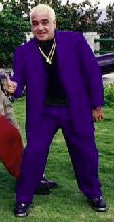 Carmelo André Llanes, has now become widely known as "el abuelo Carmelo", ("grandpa Carmelo") after the song of the same name from Charanga Habanera's latest CD, composed and sung by Aned Mota. We won't need to say anything more about his physique or his character because Aned has said it all in his song!. So we'll just focus on his artistic history.
Carmelo André Llanes, has now become widely known as "el abuelo Carmelo", ("grandpa Carmelo") after the song of the same name from Charanga Habanera's latest CD, composed and sung by Aned Mota. We won't need to say anything more about his physique or his character because Aned has said it all in his song!. So we'll just focus on his artistic history.
Carmelo, born April 3, 1953, is the oldest member of the group. To my question "Where did you study?", his answer was almost unbelievable: "a bit at Amadeo and a bit at the ENA, but what I know I learned in the streets ". All right, then, I think I want to study in the street too!!! Without a doubt the "school of the streets" produces VERY good musicians!
I continue my questions - "And what did you do then?". "I don't know,"- he tells me -"I only studied until I started playing with Lázaro Valdés (the father of Bamboleo's Lázaro Valdés, Jr.) in 'T con E'. We worked in a lot of cabarets and also accompanied many prestigious Cuban artists such as Leonora Rega, Omara Portuondo, Moraima Secada and Elena Burke. Afterwards I worked in the Teatro Musical with Rafael Ortega, and in the Cabaret Capri with Leonardo Timor, a trumpet player who now lives in the US". In addition to the many pop music groups he's also played with the orchestras of the opera and ballet and with the symphony.
Although he's great fun to interview, "El abuelo" doesn't remember that many of the details because he's played in so many groups, so we'll concentrate on the most recent!
From 1992 to 1997 he played with Paulo FG y su Elite, with whom he recorded two discs: "Sofocándote" y "El bueno soy yo". Next he worked with several other groups including César López' Havana Ensemble; Danny Lozada y su timba cubana; and Son Candela, led by bassist Adalberto "Candelita" Avila, and ex-member of Adalberto Alvarez y su son.
Since 1998 he's played with David, a name he never uses...preferring to call him "El dirigible" ("The blimp"), or, more recently, "Chocolate".
While working with La Charanga, Carmelo has also played on a number of other recording projects, such as "La recompensa" by Calixto Oviedo and Issac Delgado's "El Malecón" (released as "La fórmula" in the US, where it was nominated for a Grammy).
After a life so full of musical experiences, I came to the obligatory question: "Do you like playing with Charanga Habanera?" His response was very emotional "Hooooombre, si parece que tengo 20 años y voy a cumplir 50 ahorita! Me siento como nunca en la vida, gracias a Dios". ("Hell yes! I'm about to turn 50 and I'm acting like I'm 20! I've never felt so good in my life, thank God!")
Later he revealed that "the only thing I don't like is all the wardrobe changes...I've never had to change clothes so many times in my life!" But we all know that this goes along with the whole scene of working with this group, because in addition to their music Charanga Habanera offers a totally electrifying stage show.
***
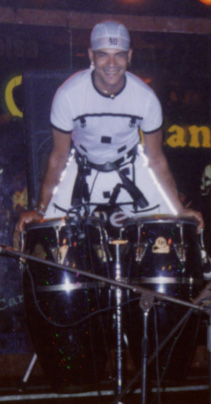 Orlandito is a worthy addition to the family that has given Cuba more rumberos than any other. His distinguished ancestry is clearly spelled out in his full name: Orlando Lázaro Mengual ABREU. Orlandito and his twin brother Lazarito truly have "music in their blood", and they both have the same talent, musical feeling, and sabrosura as the other members of their famous family, and they're living up to the promise of the musical heritage of their uncles: Luis, Alfredo (who sadly passed away very recently), Ricardo y Jesús Abreu, "Los Papines".
Orlandito is a worthy addition to the family that has given Cuba more rumberos than any other. His distinguished ancestry is clearly spelled out in his full name: Orlando Lázaro Mengual ABREU. Orlandito and his twin brother Lazarito truly have "music in their blood", and they both have the same talent, musical feeling, and sabrosura as the other members of their famous family, and they're living up to the promise of the musical heritage of their uncles: Luis, Alfredo (who sadly passed away very recently), Ricardo y Jesús Abreu, "Los Papines".
Orlandito was born on December 16, 1969, almost certainly with congas in his hands, and graduated from the "Escuela Nacional de Instructores de Arte" in 1988. Upon finishing his studies he served his obligatory year in the armed forces, and so it was that he began to play with the Conjunto Artístico de las FAR (Cuba's version of "the army band").
In 1989 he has the great privilege of doing a two month tour with Los Van Van. The following year, 1990, he and his brother joined the group Sonoridad, making an extensive tour of Europe. On returning to Cuba they joined "Los Papincitos", as guest musicians in an exciting "espectáculo" called "Noche tropical", presented in Japan, where they appeared with the "cream of the crop" of Cuban music: Carlos Embale, Celeste Mendoza, Tatagüines, Omara Portuondo, Los Papines, and Alina Torres y su Dacapo (which included Vannia Borges, now the singer of Bamboleo).
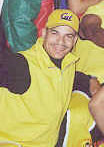 In 1993 he joined Pachito Alonso y sus Kini Kini, and stayed with them for about 5 years, recording three CD's: "Yo siempre tengo lo que tú necesitas", "Ay, qué bueno está esto" and "Una salsa en París". "And then," as he puts it "I jumped ship for the charangón of David Calzado, and I'm a very happy and lucky guy to be here in Charanga Habanera. It's given me the chance to develop both my musical skills and my showmanship".
In 1993 he joined Pachito Alonso y sus Kini Kini, and stayed with them for about 5 years, recording three CD's: "Yo siempre tengo lo que tú necesitas", "Ay, qué bueno está esto" and "Una salsa en París". "And then," as he puts it "I jumped ship for the charangón of David Calzado, and I'm a very happy and lucky guy to be here in Charanga Habanera. It's given me the chance to develop both my musical skills and my showmanship".
Charanga Habanera really has a refreshing show, and one of the most surprising highlights is the moment when Orlandito dances on his congas...it's really worth seeing...so DON'T MISS IT!!! As he himself says: "...OISTE???" ("Did you hear me?)
***
 Lázaro Jesús Mengual Abreu is as worthy of his last name as Orlandito. And they've been together throughout their artistic careers. These two brothers have never separated -- in life or in art. In physical appearance they're quite different, but in "sabor y manana" (musical soul and feeling) they're definitely twins! Like his brother, Lazarito studied at the ENIA, and played in the Conjunto Artístico de las FAR and later "Sonoridad", playing not only percussion, but bass as well.
Lázaro Jesús Mengual Abreu is as worthy of his last name as Orlandito. And they've been together throughout their artistic careers. These two brothers have never separated -- in life or in art. In physical appearance they're quite different, but in "sabor y manana" (musical soul and feeling) they're definitely twins! Like his brother, Lazarito studied at the ENIA, and played in the Conjunto Artístico de las FAR and later "Sonoridad", playing not only percussion, but bass as well.
 In 1992 the careers of the two brothers separated for the second time, (the first being Orlandito's 2 month tour with Los Van Van). Lazarito took a job with Alina Torres y Dacapo -- a tour which included France and Africa, among other places..
In 1992 the careers of the two brothers separated for the second time, (the first being Orlandito's 2 month tour with Los Van Van). Lazarito took a job with Alina Torres y Dacapo -- a tour which included France and Africa, among other places..
Later, reunited with Orlandito again, he joined Pachito Alonso y sus Kini Kini, for about 4 years, until, in 1998, he too decided to become a Charanguero. "I'm very happy here -- I've gotten to visit many new places, and I've had the chance to develop in the music scene and on my instrument...what else can I say? I love it here!"
***
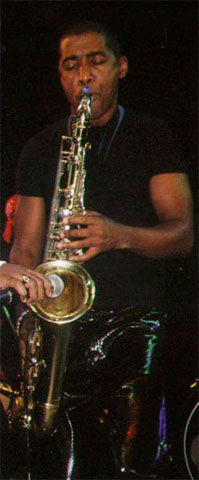 "Collado, vamos! Tira esa flauta pa’lante… ", sings Tirso Duarte as the flute solo begins near the end of Alina Torres' "El Cantinero" from the album "Charanguero Mayor".
"Collado, vamos! Tira esa flauta pa’lante… ", sings Tirso Duarte as the flute solo begins near the end of Alina Torres' "El Cantinero" from the album "Charanguero Mayor".
The flautist's name is Osmani Collado Martínez, born September 30, 1966. He graduated from the ENA in 1985, and upon completing his studies he headed for Pinar del Rio to fulfill his year of social service with the group “Son Ireme”, and at the vocational school there.
“In 1987 I worked with Pablo Menéndez group Mezcla, and later joined up with the late Martha Jean Claude. I was there about four years and we recorded 2 discs”.
In 1991 he joined Yumurí y sus hermanos, with whom he recorded another two discs, “Cocodrilo de agua salá” and “Provocación”, which included some of his own compositions.
“These were the first recordings of my music but I'd actually been composing and arranging for some time. Since I was little I had listened to my father play the piano and he taught me a lot”.
I myself played some of Osmany's arrangements (very good ones I might add) during my short time playing with the all-female band “Salsa Morena”.
Osmany was musical director “Química Perfecta” for a year and a half, just before joining Charanga Habanera in August of 1998.
“One of my songs, “Mambo Sato” o “Mambo # Cuba” is included on the latest CD ("Chan Chan Charanga"). I'm doing a lot more with La Habanera now: playing sax, flute and synth. I also sometimes help David with the arrangements when we're getting a new song ready. I'm doing what I want and I'm very happy here. I keep learning, and preparing myself for the new things that come up every day. For example, I just wrote some new arrangements of my songs, “Sonrisa mágica” and “Un consejo sano” for Mike Gerald of Sol y Soul, and he asked me to do some more work on his next record. Little by little my songs and arrangements are making their way into recording projects all over the world."
Well, as Yulién says to open the Charanga show: “Osmani!!!…are you ready for the Charanga?”
***
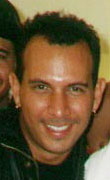 Juan Manuel Jiménez Chávez also came from a musical family - his father studied the piano, although he didn't make it his career, and his sister is an excellent flautist.
Juan Manuel Jiménez Chávez also came from a musical family - his father studied the piano, although he didn't make it his career, and his sister is an excellent flautist.
Juan Manuel was born August 9, 1973, and studied trumpet at Guillermo Tomás, at Amadeo Roldán and later graduated from the ISA in 1997.
Even when he was studying a Amadeo he had already begun to play professionally. “I played gigs here and there, first with Orquesta del Circo, and then in the Capri with Caribe Expreso and at the Hotel Habana Libre with La Riverside”. He continued gigging with various groups such as Colé Colé (1994), Yumurí y sus hermanos (1995-1996), Alto Voltaje, and Rojitas y su orquesta (1997-1998). “And from the summer of '98 I've been with La Charanga”.
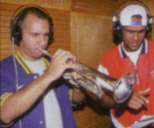 Since joining Charanga Habanera he's also continued to record "por ahí", including Calixto Oviedo's CD “La recompensa” and last year's Grammy-winning “La rumba soy yo”, in addition to other productions of leading arranger/producers Joaquín Betancourt, and his namesake Juan Manuel Ceruto.
Since joining Charanga Habanera he's also continued to record "por ahí", including Calixto Oviedo's CD “La recompensa” and last year's Grammy-winning “La rumba soy yo”, in addition to other productions of leading arranger/producers Joaquín Betancourt, and his namesake Juan Manuel Ceruto.
“La Charanga gives me the chance to play various genres of music, not just Timba, but also some traditional music and I play a solo here and there, and that makes me happy. I'm very happy in my job and also in my personal life: I just had a daughter who's only 23 days old.
Congratulation, papá Juan Manuel !!!
***
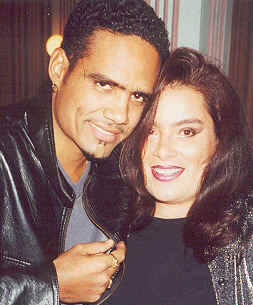 Aned “Cinturita” Mota Centeno “born in Havana under the sign of Aries, March 25th, 1974, and...well, here we are in March again”. He studied a bit of economy “because you've gotta know how to pay the bills". Later, about 1995, after his obligatory year of military service, he took a course in modeling, but he gave it up because "I didn't like it much there and right here is where I see myself”.
Aned “Cinturita” Mota Centeno “born in Havana under the sign of Aries, March 25th, 1974, and...well, here we are in March again”. He studied a bit of economy “because you've gotta know how to pay the bills". Later, about 1995, after his obligatory year of military service, he took a course in modeling, but he gave it up because "I didn't like it much there and right here is where I see myself”.
“I first started to try my handing at singing in "Los Chicos de la Salsa", together with my cousin Liena Hernández, now the trombonist of Anacaona. I liked music -- it was something new to me -- and I got the fever to sing.” - and not only Aned. It seems that his older brother, inspired by Aned's success, has also decided to take up singing.
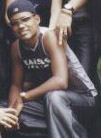 “I went from "Los Chicos" to "La Farandula", a new band, in 1997 and I was with them until '98, when I became part of this family, La Charanga Habanera”.
“I went from "Los Chicos" to "La Farandula", a new band, in 1997 and I was with them until '98, when I became part of this family, La Charanga Habanera”.
He also sang on Calixto Oviedo's “La recompensa” in 2000, y he made his debut as a composer on the new Charanga Habanera disc, “with a song that I dedicated to the professor”. The song is called “El abuelo Carmelo”.
About his guías he told me "I like to work on my guías, especially the rhymes and rhythms, and I always get a lot of guidance from the 'motor' of the group, Sergio David Calzado".
Aned dance moves on stage have earned him the very approriate nickname, “Cinturita”. On the dance floor he's an artist who knows his job and does it well. Away from the stage he's the same regular guy I'm known for so long, except that he's become a happy father, with two kids, and a wife who's also a famous singer, Haila María Mompié, of Bamboleo, and later Azúcar Negra.
***
Randy Malcom Martínez
In April 2004 Randy joined La Charanga Habanera where he can use his talents as percussionist, dancer and singer.
Amey Randy ¡el menorcito, of 19 y 42! was one of the youngest members of 'El Clan' and is now one of the youngest members of La Charanga Habanera. He was born in Guanabacoa, Ciudad Habana, January 22, 1983 He began his studies at the age of 8 in the school Alejandro García Caturla. Then he became part of groups such as 'Habana Junior' and 'Carlos Manuel y su clan' where he recorded his first CDs: 'Por la vena al gusto' and 'Enamora'o'. But he is not only an excellent percussionist, but during the show he would leave the drums and give the audience all the rhythm and sabor cubano with his body movement. Among his favorite musicians are Alejandro Sanz, Luis Miguel and Marc Anthony there is no doubt he is in love with life, by chance was he born loving? and as could be expected he can't let pass top-line groups such as Charanga Habanera, Van Van, Bamboleo, Pupi y los que son son among others. His inclination for percussion is closely related to the fact that his father Raymundo Martínez was the percussionist and director of a salsa group called 'Calle 42' and like father like son. Randy is a very easy going guy, charismatic, smiling and with a great sense of humor. This young man has dreamed of singing one day, so don't be surprised if you hear him singing with La Charanga Habanera!

Aned “Cinturita” Mota Centeno “born in Havana under the sign of Aries, March 25th, 1974, and...well, here we are in March again”. He studied a bit of economy “because you've gotta know how to pay the bills". Later, about 1995, after his obligatory year of military service, he took a course in modeling, but he gave it up because "I didn't like it much there and right here is where I see myself”.
“I first started to try my handing at singing in "Los Chicos de la Salsa", together with my cousin Liena Hernández, now the trombonist of Anacaona. I liked music -- it was something new to me -- and I got the fever to sing.” - and not only Aned. It seems that his older brother, inspired by Aned's success, has also decided to take up singing.
 “I went from "Los Chicos" to "La Farandula", a new band, in 1997 and I was with them until '98, when I became part of this family, La Charanga Habanera”.
“I went from "Los Chicos" to "La Farandula", a new band, in 1997 and I was with them until '98, when I became part of this family, La Charanga Habanera”.
He also sang on Calixto Oviedo's “La recompensa” in 2000, y he made his debut as a composer on the new Charanga Habanera disc, “with a song that I dedicated to the professor”. The song is called “El abuelo Carmelo”.
About his guías he told me "I like to work on my guías, especially the rhymes and rhythms, and I always get a lot of guidance from the 'motor' of the group, Sergio David Calzado".
Aned dance moves on stage have earned him the very approriate nickname, “Cinturita”. On the dance floor he's an artist who knows his job and does it well. Away from the stage he's the same regular guy I'm known for so long, except that he's become a happy father, with two kids, and a wife who's also a famous singer, Haila María Mompié, of Bamboleo, and later Azúcar Negra.
***
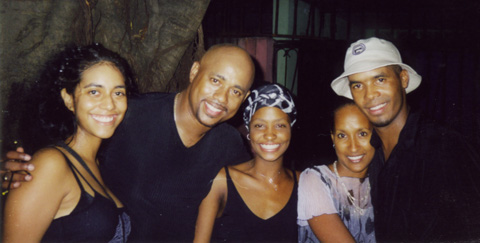
Majela Serrano with David Calzado, Liset, Zoe, and Helder Rojas



















